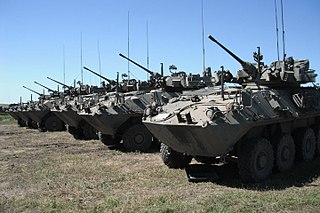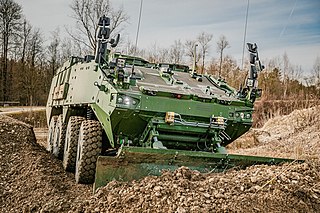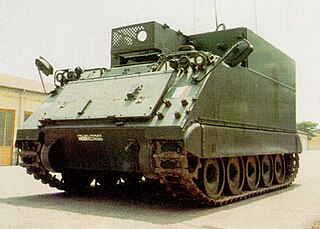
The Combat Vehicle 90 (CV90) is a family of Swedish tracked armoured combat vehicles designed by the Swedish Defence Materiel Administration (FMV), Hägglunds and Bofors during the mid-1980s to early 1990s, before entering service in Sweden in the mid-1990s. The CV90 platform design has continuously evolved from the Mk 0 to the current Mk IV with technological advances and changing battlefield requirements. The Swedish version of the main infantry fighting vehicle (IFV) is fitted with a turret from Bofors equipped with a 40 mm Bofors autocannon. Export versions are fitted with Hägglunds E-series turrets, armed with either a 30 mm Mk44 or a 35 mm Bushmaster autocannon.

The M113 is a fully tracked armored personnel carrier (APC) that was developed and produced by the FMC Corporation. The M113 was sent to United States Army Europe in 1961 to replace the mechanized infantry's M59 APCs. The M113 was first used in combat in April 1962 after the United States provided the South Vietnamese army (ARVN) with heavy weaponry such as the M113, under the Military Assistance Command, Vietnam (MACV) program. Eventually, the M113 was the most widely used armored vehicle of the U.S. Army in the Vietnam War and was used to break through heavy thickets in the midst of the jungle to attack and overrun enemy positions. It was largely known as an "APC" or an "ACAV" by the allied forces.

The Patria AMV is an 8×8 multi-role military vehicle produced by the Finnish defence industry company Patria.

The Mowag Piranha is a family of armoured fighting vehicles designed by the Swiss company Mowag.

The Boxer is a multirole armoured fighting vehicle designed by an international consortium to accomplish a number of operations through the use of installable mission modules. The governments participating in the Boxer programme have changed as the programme has developed. The Boxer vehicle is produced by the ARTEC GmbH industrial group, and the programme is being managed by OCCAR. ARTEC GmbH is based in Munich; its parent companies are Krauss-Maffei Wegmann GmbH and Rheinmetall Military Vehicles GmbH on the German side, and Rheinmetall Defence Nederland B.V. for the Netherlands. Overall, Rheinmetall has a 64% stake in the joint venture.

The LAV II Bison and Coyote are armoured cars, or armoured personnel carriers built by General Dynamics Land Systems Canada for the Canadian Armed Forces. It is based on the Mowag Piranha 8x8.

The Australian Light Armoured Vehicle (ASLAV) is an eight-wheeled armoured reconnaissance vehicle of the LAV II family used by the Australian Army. It was built by General Dynamics Land Systems Canada, and developed from the U.S. Marine Corps' LAV-25 and Canadian Army's Bison armoured fighting vehicles.

The Bionix (BX) is a family of tracked Singaporean armoured fighting vehicles developed by ST Kinetics. Intended to augment the Singapore Army's aging M113 armoured personnel carriers, it is the first indigenous armoured vehicle to be developed in Southeast Asia. The Bionix has been operational with the Singapore Armed Forces (SAF) since 1999 in a wide variety of adaptations including the Bionix II, Bionix 25 and Bionix 40/50 variants.

The ASCOD armoured fighting vehicle family is the product of a cooperation agreement between Austrian Steyr-Daimler-Puch AG and Spanish General Dynamics Santa Bárbara Sistemas. Both companies are now divisions of a unit of General Dynamics. The ASCOD family includes the LT 105 light tank equipped with a 105 mm gun, a surface-to-air missile launcher, an anti-tank guided missile launcher, mortar carrier, R&R vehicle, command-and-control vehicle, ambulance, artillery observer, and the AIFV model.

The Véhicule Blindé de Combat d'Infanterie or VBCI is a French Infantry fighting vehicle designed and manufactured by GYAT Industries and Renault Trucks Defense to replace the AMX-10P. The first units entered active service with the French Army in 2008. 630 units were ordered and full delivery was completed in 2018. Spain and the UK have notably shown interest in acquiring the vehicle but ultimately opted for domestic options instead.
A huge number of M113 Armored Personnel Carrier variants have been created, ranging from infantry carriers to nuclear missile carriers. The M113 armored personnel carrier has become one of the most prolific armored vehicles of the second half of the 20th century, and continues to serve with armies around the world in many roles.

The Piranha IV is the fourth generation of the Piranha family of armoured vehicles by MOWAG GmbH. Its development started in the 2000s as a fully private venture. A first prototype was unveiled in 2001, and a second in 2004. This new version offered an increased volume inside the cabin, and a higher level of protection.

The Piranha V Infantry Fighting Vehicle (IFV) is the fifth generation variant of the Mowag Piranha family of vehicles. It was designed by General Dynamics European Land Systems - Mowag GmbH. The first prototype was completed in 2008. It was first introduced during the Eurosatory exhibition in 2010.

The VBM – Freccia is a family of 8x8 armoured vehicles that was designed and manufactured for the Italian Army by IVECO for the hull, the engine and the suspension, and OTO Melara for the armament. The first variant to be developed was the IFV, the Freccia being equipped with a Hitfist turret, the same as the one installed on the Dardo IFV.
The Flensburger Fahrzeugbau Gesellschaft mbH (FFG) is a medium-sized company based in Flensburg, Germany. It operates in the military vehicle manufacturing, maintenance, and upgrade business sectors.

The Lynx is a German armoured fighting vehicle developed by Rheinmetall Landsysteme. The Lynx, configured as a KF31 infantry fighting vehicle (IFV), was unveiled at the Eurosatory defence exhibition on 14 June 2016. The KF41 variant was unveiled at the Eurosatory defence exhibition on 12 June 2018. According to Rheinmetall, the Lynx family of tracked armoured vehicles is at the forefront of a new trend in IFV design toward armoured vehicles with lower unit and through-life costs and reduced complexity. One of the key principles of the Lynx concept is the integration of proven sub-systems with a high technology readiness level to reduce development time, cost and technical risk.

The Australian Army has operated M113 armoured personnel carriers since 1964. An initial pair of M113s was purchased for trials purposes in 1962. Either 817 or 840 were acquired by 1979, comprising nine different variants. A long-running modernisation program that commenced in the 1990s resulted in 431 M113s being upgraded between 2007 and 2012. All of the upgraded M113s remain in service as of 2020.

The LAV 6, sometimes written as LAV 6.0 or LAV VI, is the fourth generation of LAV, and is based on the LAV III. The first vehicles were delivered in 2013 and after testing entered service in 2016. The Canadian Army plans to replace its entire LAV fleet of various LAV II and LAV III variants with the LAV 6. The vehicle is being acquired in two main variants: a fighting vehicle equipped with the 25mm cannon seen on the LAV II and LAV III, and a support variant labelled the Armoured Combat Support Vehicle (ACSV).

The M577 Command Post Carrier, also known as the M577 Command Post Vehicle or Armored Command Post Vehicle, is a variant of the M113 Armored Personnel Carrier that was developed and produced by the Food Machinery and Chemical Corporation (FMC) to function on the battlefield as a mobile command post i.e. a tactical operations centre, usually at the battalion level. In U.S. military service its official designation is Carrier, Command Post, Light Tracked M577.

















